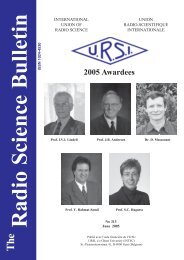Radio Science Bulletin 325 - June 2008 - URSI
Radio Science Bulletin 325 - June 2008 - URSI
Radio Science Bulletin 325 - June 2008 - URSI
- No tags were found...
Create successful ePaper yourself
Turn your PDF publications into a flip-book with our unique Google optimized e-Paper software.
directed boresight and, similar to the ROTHR in Virginia,can look toward the equatorial zone. At the dinner for anOTH radar meeting at Hanscom Air Force Base, aroundhors d’oeuvres, I became involved in a conversation aboutspread Doppler clutter with Dr. Jason Providakes (MITRE)and Dr. Bruce Ward of the Australian Defence <strong>Science</strong>Technology Organisation (DSTO). The first ROTHRproduction system had just been fielded on the island ofAmchitka in the Aleutians, with a boresight that allowedillumination of the Australian JFAS radar. Likewise, theJFAS radar, if steered to its easternmost extent, could justbarely illuminate the Amchitka ROTHR. Bruce and Jasonhit upon the idea for a one-way/two-way experiment, wherethe signals from each opposing radar would be received bythe other radar as well as itself. To make a long story short,the experiment was conducted, and the result conclusivelyproved that spread Doppler clutter was being caused byphase-modulated ground clutter from propagation modestransiting the structured low-latitude ionosphere.became specular. A surprising thing, first noted by Dr.Chris Coleman, was that some rays from mid-latitudeequatorial-looking OTH radars could achieve orthogonalitywith the low-latitude geomagnetic field. The dip angle ofthe geomagnetic field in the region of the AppletonAnomalies was such that certain rays on certain hops, ontheir way back down from an ionospheric reflection, couldimpinge orthogonally on geomagnetic field-aligned structurethat might be present. At Coleman’s encouragement, weincluded the calculation of such coherent backscatter clutterin the Clutter Effects Model by monitoring the aspect angleof our Haselgrove rays with the geomagnetic field andflagging near orthogonality when it occurred, then computingthe Born backscatter cross section on WBMOD-generatedstructure that might be there.We at MRC set about developing a capability tosimulate spread Doppler clutter, and to provide a predictivecapability that could be used to assist OTH radar siteselection or to predict its effects over a solar cycle. Aparallel spread-Doppler-clutter simulation capability waspursued by Dr. Chris Coleman at DSTO [7]. We called ourspread Doppler clutter simulator CLEM, for Clutter EffectsModel [18]. Clutter Effects Model uses WBMOD, aclimatological model for the occurrence of small-scaleionization structure [19, 20] to define the geographicalcoverage and strength of the scattering regions as a functionof time of day, season, and solar cycle. Haselgrove raytracing is used to compute the OTH radar propagation pathsin a climatological ionosphere model. Since the simulationrequires extensive ray-tracing calculations, we made use ofan extremely fast – albeit two-dimensional – ray-tracingprogram provided by Dr. Chris Coleman [8].The Clutter Effects Model includes all the radar signalprocessing required to simulate OTH radar clutter returns,including range and Doppler folding, ray focusing andabsorption, and a ground/sea map to allow different forward/backscatter losses to be applied. We also includedgeomagnetic field-aligned backscatter, because small-scaleionization structure tends to stretch out along thegeomagnetic field, specular scatter from the elongatedstructure is coherent, and if the illumination becomesorthogonal to that structure, then very bright backscatterclutter occurs. This field-aligned backscatter clutter waswell known to the operators of the OTH-B system whenlooking northward through the polar ionosphere, sinceorthogonal illumination of the near-vertical field-alignedpolar ionization structure was easily achieved for theirhighly oblique ray paths. Specular coherent scatter was alsoobserved in the one-way/two-way JFAS-ROTHRexperiment from field-aligned equatorial ionizationstructure. As the beams of the two radars were swept acrosslongitude, a bright clutter return was observed on the onewaypaths when the scattering angle between the two radarsFigure 7. An amplitude-range-Doppler plotof CLEM-predicted spread Doppler clutterfor a hypothetical southerly-directed,northern-latitude OTH radar (after Laueret al. [18, Plate 4]).44The<strong>Radio</strong> <strong>Science</strong> <strong>Bulletin</strong> No <strong>325</strong> (<strong>June</strong> <strong>2008</strong>)
















